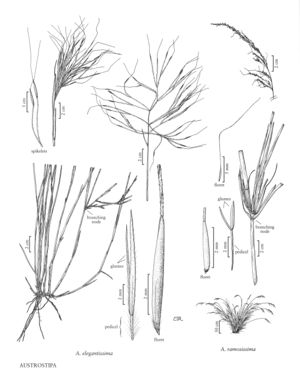Difference between revisions of "Austrostipa elegantissima"
FNA>Volume Importer |
FNA>Volume Importer |
||
| Line 39: | Line 39: | ||
|publication year= | |publication year= | ||
|special status= | |special status= | ||
| − | |source xml=https://jpend@bitbucket.org/aafc-mbb/fna-data-curation.git/src/ | + | |source xml=https://jpend@bitbucket.org/aafc-mbb/fna-data-curation.git/src/f6b125a955440c0872999024f038d74684f65921/coarse_grained_fna_xml/V24/V24_254.xml |
|subfamily=Poaceae subfam. Pooideae | |subfamily=Poaceae subfam. Pooideae | ||
|tribe=Poaceae tribe Stipeae | |tribe=Poaceae tribe Stipeae | ||
Revision as of 20:14, 24 September 2019
Plants perennial; to 2 m, shrubby; cespitose, shortly rhizomatous. Culms decumbent, branched, with 3-6(10) nodes, glabrous. Leaves not forming a basal cluster; sheaths becoming somewhat free, glabrous, often somewhat ribbed; ligules 2-3 mm, obtuse, erose, glabrous; blades (2)5-7.5 cm long, 1.5-2 mm wide, tightly rolled, glabrous, sometimes scabrous, margins glabrous, sometimes scabrous. Panicles 14-25 cm, open, with whorls of branches bearing few spikelets, detached at maturity; branches and pedicels plumose, hairs 1.5-3 mm. Glumes 7-12 mm, 3-veined basally, veins pilose; florets 4.5-10 mm, narrowly cylindrical; calluses 0.5-0.8 mm, nearly straight, sericeous; lemmas tuberculate, mostly glabrous, black when mature, margins with short strigose hairs proximally; awns 2-5 cm, once- or twice-geniculate, first segment scabrous; paleas about 1/2 the length of the lemmas; anthers 1.5-3 mm, penicillate. Caryopses 4-5 mm. 2n = unknown.
Discussion
Austrostipa elegantissima is native to southern Australia. It is cultivated as an ornamental in the United States.
Selected References
None.
